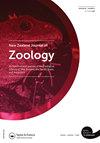使用人工廊道对树木wātā(Hemidina spp.)进行非致命监测的建议
IF 1.1
4区 生物学
Q3 ZOOLOGY
引用次数: 0
摘要
摘要新西兰奥特亚的野生动物保护区涉及社区团体,他们通常更喜欢使用非致命的无脊椎动物监测方法。为了改进监测设计,我们研究了一种监测树wātā的方法。在我们的研究之前,我们研究地点的害虫管理在10年内没有变化,在两次采样之间保持不变,因此我们假设在研究的四年内,树木wātā的丰度不会有显著变化。我们记录了入住情况,并每1-2周使用同一组38个人工树洞避难所(廊道)标记每棵树wātā(Hemidina spp.)。我们通过使用相隔四年的同一画廊比较树木wātā的数量,测试了对树木wītā的非致命监测是相对wā丰度的合适代表的预测。正如预期的那样,wātā的数量没有变化。然而,场地/画廊的保真度、季节波动和人工画廊之间的移动表明,监测设计需要结合这些昆虫的生活史和行为。我们建议将wātā的入住率限制在同一季节,画廊数量超过50个 我一年只检查一两次。本文章由计算机程序翻译,如有差异,请以英文原文为准。
Recommendations for non-lethal monitoring of tree wētā (Hemideina spp.) using artificial galleries
ABSTRACT Wildlife sanctuaries in Aotearoa/New Zealand involve community groups that often prefer using non-lethal monitoring methods for invertebrates. We examined one method for monitoring tree wētā with the aim of improving monitoring design. Pest management at our study site did not vary for 10 years before our study and remained unchanged between sampling, so we assumed that abundance of tree wētā would not vary significantly over the four years of the study. We recorded occupancy and marked every tree wētā (Hemideina spp.) using the same set of 38 artificial tree-hole refuges (galleries) every 1–2 weeks. We tested the prediction that non-lethal monitoring of tree wētā is a suitable proxy for relative wētā abundance by comparing the number of tree wētā using the same galleries four years apart. As expected, no change in numbers of wētā was detected. However, the level of site/gallery fidelity, seasonal fluctuations and movement between artificial galleries suggest that monitoring design needs to incorporate the life history and behaviour of these insects. We recommend comparison of wētā occupancy be restricted to the same season, galleries be placed more than 50 m apart and checked only once or twice a year.
求助全文
通过发布文献求助,成功后即可免费获取论文全文。
去求助
来源期刊
CiteScore
2.80
自引率
0.00%
发文量
20
审稿时长
>12 weeks
期刊介绍:
Aims: The diversity of the fauna of the southern continents and oceans is of worldwide interest to researchers in universities, museums, and other centres. The New Zealand Journal of Zoology plays an important role in disseminating information on field-based, experimental, and theoretical research on the zoology of the region.

 求助内容:
求助内容: 应助结果提醒方式:
应助结果提醒方式:


